Neamen D. Microelectronics: Circuit Analysis and Design
Подождите немного. Документ загружается.


5. Describe what is meant by the terms (a) gain sensitivity and (b) bandwidth
extension.
6. Describe the series and shunt input connections of a feedback amplifier.
7. Describe the series and shunt output connections of a feedback amplifier.
8. Describe the effect of a series or shunt input connection on the value of input
resistance.
9. Describe the effect of a series or shunt output connection on the value of output
resistance.
10. Consider a noninverting op-amp circuit. Describe the type of input and output
feedback connections.
11. Consider an inverting op-amp circuit. Describe the type of input and output
feedback connections.
12. What is the Nyquist stability criterion for a feedback amplifier?
13. Using Bode plots, describe the conditions of stability and instability in a feed-
back amplifier.
14. Define phase margin.
15. What is meant by frequency compensation?
16. What is a dominant pole?
17. What is a common technique of frequency compensation in a feedback amplifier?
PROBLEMS
Basic Feedback Concepts
12.1 (a) A negative-feedback amplifier has a closed-loop gain of
A
f
= 100
and
an open-loop gain of
A = 5 ×10
4
. Determine the feedback transfer func-
tion
β
. (b) If
β = 0.012
and
A
f
= 80
, determine the open-loop gain
A
.
12.2 (a) The closed-loop gain of a negative-feedback amplifier is
A
f
=−80
and
the open-loop gain is
A =−10
5
. Find the feedback transfer function
β
.
(b) If
β =−0.015
and
A =−5 ×10
4
, determine the closed-loop gain
A
f
.
12.3 The ideal feedback transfer function is given by Equation (12.5). (a) As-
sume the feedback transfer function is
β = 0.15
. Determine the loop gain T
and the closed-loop gain A
f
for (i)
A =∞
, (ii)
A = 80
dB, and (c)
A = 10
2
. (b) Repeat part (a) for
β = 0.25
.
12.4 (a) The closed-loop gain of a feedback amplifier using an ideal feedback
amplifier
(A →∞)
is
A
f
= 125
. What is the value of
β
? (b) If the basic
amplifier has a finite open-loop gain, what must be the value of A such that
the closed-loop gain is within 0.25 percent of the ideal value. Use the results
of part (a).
12.5 Consider the feedback system shown in Figure 12.1. The closed-loop gain
is
A
f
=−80
and the open-loop gain is
A =−2 ×10
4
. (a) Determine the
feedback transfer function
β
. (b) The closed-loop gain is not to change by
more than 0.01 percent when the open-loop gain changes. What is the max-
imum allowed change in the open-loop gain?
12.6 The open-loop gain of an amplifier is
A = 5 ×10
4
. If the open-loop gain
decreases by 10 percent, the closed-loop gain must not change by more
than 0.1 percent. Determine the required value of the feedback transfer
function
β
and the closed-loop gain A
f
.
12.7 Two feedback configurations are shown in Figures P12.7(a) and P12.7(b).
The closed-loop gain in each case is
A
v f
= v
o
/v
i
= 50
. (a) Determine
β
1
928 Part 2 Analog Electronics
nea80644_ch12_851-946.qxd 6/23/09 1:45 PM Page 928 pmath DATA-DISK:Desktop Folder:23/06/09:MHDQ134-12:
Section 12.2
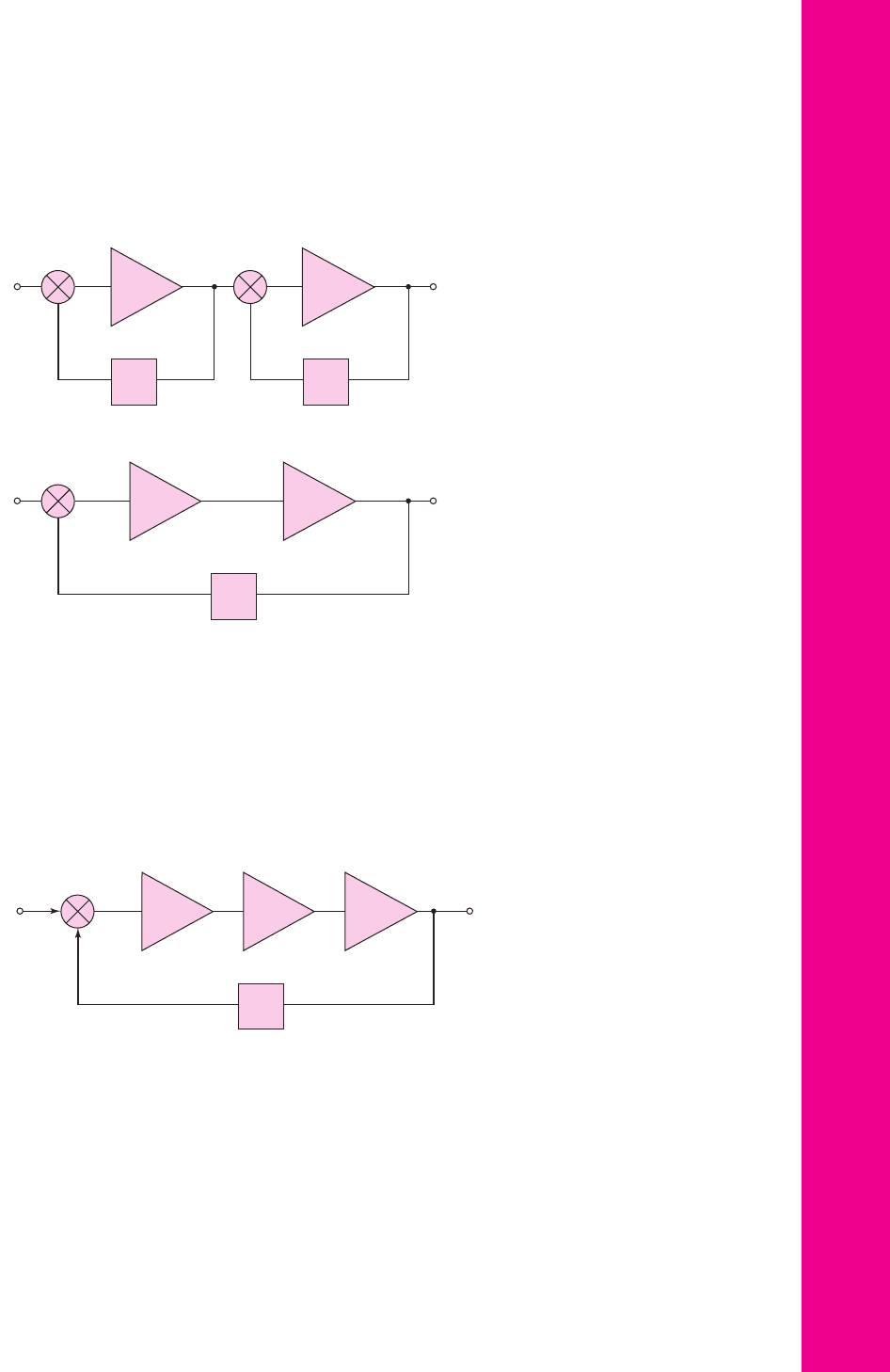
Chapter 12 Feedback and Stability 929
12.8 Three voltage amplifiers are in cascade as shown in Figure P12.8 with var-
ious amplification factors. The 180 degree phase shift for negative feedback
actually occurs in the basic amplifier itself. (a) Determine the value of
β
such that the closed-loop voltage gain is
A
v f
= V
o
/V
s
=−120
. (b) Using
the results of part (a), determine the percent change in
A
v f
if each individ-
ual amplifier gain decreases by 10 percent.
A
1
= 200
+
–
A
2
= 10
b
1
v
i
v
o
+
–
b
1
A
1
= 200
+
–
A
2
= 10
v
i
v
o
b
2
(a)
(b)
Figure P12.7
A
1
= –10
+
+
A
2
= –15 A
3
= –20
b
V
s
V
o
V
fb
V
e
Figure P12.8
12.9 (a) The open-loop low-frequency voltage gain of an amplifier is
A
v
=
5 × 10
4
and the open-loop 3 dB frequency is
f
H
= 10
Hz. If the closed-loop
low-frequency gain is
A
v f
= 25
, what is the closed-loop bandwidth? (b) The
minimum closed-loop bandwidth of a feedback amplifier is to be 20 kHz. The
open-loop low-frequency voltage gain is
A
v
= 10
5
and the open-loop 3 dB
frequency is
f
H
= 8
Hz. What is the maximum closed-loop voltage gain?
12.10 (a) Determine the closed-loop bandwidth of a noninverting amplifier with a
closed-loop low-frequency gain of 50. The op-amp has the characteristics
and
β
2
for the two circuits. (b) The gain
A
2
decreases by 10 percent in both
circuits. Using the results of part (a), determine the percent change in the
closed-loop gain for each circuit. (c) What conclusion can be made as to the
“better” feedback configuration?
nea80644_ch12_851-946.qxd 6/23/09 1:45 PM Page 929 pmath DATA-DISK:Desktop Folder:23/06/09:MHDQ134-12:

described in Problem 12.9(a). (b) If the open-loop gain decreases to
A
v
= 10
4
but the closed-loop low-frequency gain remains fixed at 50, what
is the resulting closed-loop bandwidth?
12.11 (a) An inverting amplifier uses an op-amp with an open-loop 3 dB fre-
quency of 5 Hz. The closed-loop low-frequency gain is to be
A
v f
= 75
and the closed-loop bandwidth is to be 35 kHz. (i) What is the required
value of the open-loop low-frequency gain? (ii) Determine the feedback
transfer function
β
. (b) Using the results of part (a), what is the closed-loop
bandwidth and closed-loop low-frequency gain if the open-loop low-
frequency gain decreases by 10 percent?
12.12 The basic amplifier in a feedback configuration has a low-frequency gain of
A = 5000
and two pole frequencies at f
3-dB1
= 10 Hz and f
3-dB2
= 2 kHz.
The low-frequency closed-loop gain is
A
f
= 100
. Determine the two 3 dB
frequencies of the closed-loop system.
12.13 Consider the two feedback networks shown in Figures P12.7(a) and
P12.7(b). The 3 dB frequency of the amplifier A
1
is 100 Hz and the 3 dB fre-
quency of the second amplifier A
2
is very large. The feedback transfer func-
tions are
β
1
= 0.1126
and
β
2
= 0.0245
. (a) Determine the 3 dB frequency
of each closed-loop network. (b) What conclusion can be made as to the
“better” closed-loop system?
12.14 Consider two open-loop amplifiers in cascade, with a noise signal generated
between the two amplifiers as in Figure 12.3(a). Assume the amplification of the
first stage is
A
2
= 100
and that of the second stage is
A
1
= 1
. If
V
in
= 10
mV
and
V
n
= 1
mV, determine the signal-to-noise ratio at the output.
12.15 Two feedback configurations are shown in Figures P12.15(a) and (b). At low
input voltages, the two gains are
A
1
= A
2
= 90
and at higher input voltages,
the gains change to
A
1
= A
2
= 60
. Determine the change in closed-loop
gain,
A
f
= V
o
/V
i
, for the two feedback circuits. (See Figure 12.4.) Which
feedback configuration will result in less distortion in the output signal?
b = 0.1 b = 0.1
b = 0.0122
A
1
A
1
A
2
A
2
+
–
+
–
+
–
V
i
V
i
V
o
V
o
(a)
(b)
Figure P12.15
930 Part 2 Analog Electronics
nea80644_ch12_851-946.qxd 6/23/09 1:45 PM Page 930 pmath DATA-DISK:Desktop Folder:23/06/09:MHDQ134-12:

Chapter 12 Feedback and Stability 931
v
o
v
s
R
2
R
1
R
if
R
of
+
–
+
–
–
+
Figure P12.18
Section 12.3 Ideal Feedback Topologies
12.16 Consider the ideal series-shunt circuit shown in Figure 12.6. Let
A
v
= 5 ×
10
3
V/V
,
β = 0.0080 V/V
,
R
i
= 10 k
, and
R
o
= 1k
. Determine the
ideal values of
A
v f
= V
o
/V
i
,
R
if
, and
R
of
.
12.17 The parameters of the ideal series–shunt circuit shown in Figure 12.6 are
V
i
= 25
mV,
V
o
= 2.5
V, and
β = 0.0096
V/V. Determine the values and
units of
A
v
,
A
v f
,
V
fb
, and
V
ε
.
12.18 For the noninverting op-amp circuit in Figure P12.18, the parameters are:
A = 10
5
,
A
v f
= 20
,
R
i
= 100 k
, and
R
o
= 100
. Determine the ideal
closed-loop input and output resistances,
R
if
and
R
of
, respectively.
12.19 Consider the noninverting op-amp circuit in Figure P12.18. The input resis-
tance of the op-amp is
R
i
=∞
and the output resistance is
R
o
= 0
, but the op-
amp has a finite gain A. (a) Write the closed-loop transfer function in the form
A
v f
=
v
o
v
s
=
A
(1 + β A)
(b) What is the expression for
β
? (c) If
A = 10
5
and
A
v f
= 20
, what is the
required
β
and
R
2
/R
1
? (d) If A decreases by 10 percent, what is the percent
change in
A
v f
?
12.20 The circuit parameters of the ideal shunt–series amplifier shown in Figure
12.9 are
I
i
= 20 μ
A,
I
fb
= 19 μ
A,
R
i
= 500
,
R
o
= 20 k
, and
β
i
=
0.0095
A/A. Determine the values and units of
I
ε
,
I
o
,
A
i
,
A
if
,
R
if
, and
R
of
.
12.21 Consider the ideal shunt–series amplifier shown in Figure 12.9. The para-
meters are
I
i
= 25 μ
A,
I
ε
= 0.8 μ
A, and
A
if
= 125
. Determine the values
and units of
I
fb
,
I
o
,
β
i
, and
A
i
.
12.22 Consider the op-amp circuit in Figure P12.22. The op-amp has a finite gain,
so that
i
o
= Ai
ε
, and a zero output impedance. (a) Write the closed-loop
transfer function in the form
A
if
=
i
o
i
s
=
A
i
(1 + β
i
A
i
)
(b) What is the expression for
β
i
? (c) If
A
i
= 10
5
and
A
if
= 25
, what is the
required
β
i
and
R
F
/R
3
? (d) If A
i
decreases by 15 percent, what is the per-
cent change in
A
if
?
12.23 An op-amp circuit is shown in Figure P12.22. Its parameters are as described
in Problem 12.22, except that
R
i
= 2k
and
R
o
= 20 k
. Determine the
closed-loop input and output resistances,
R
if
and
R
of
, respectively.
nea80644_ch12_851-946.qxd 6/23/09 1:45 PM Page 931 pmath DATA-DISK:Desktop Folder:23/06/09:MHDQ134-12:
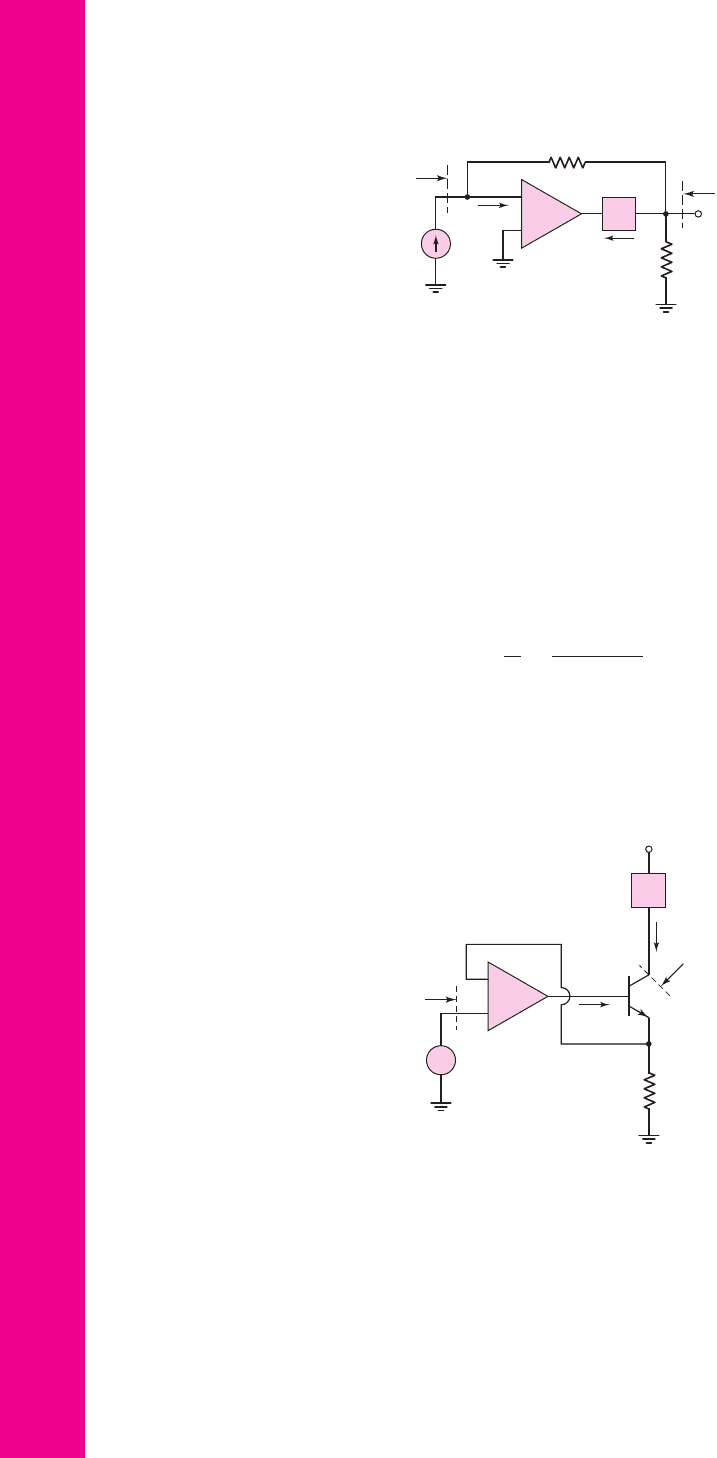
v
s
i
o
′
–
+
i
o
Z
L
R
E
V
+
–
+
v
e
R
if
R
of
+
–
Figure P12.26
12.24 The parameters of the ideal series–series amplifier in Figure 12.12 are
V
i
= 0.2
mV,
I
o
= 5
mA,
V
fb
= 0.195
mV,
R
i
= 20 k
, and
R
o
= 10 k
.
Determine the values and units of
V
ε
,
β
z
,
A
gf
,
A
g
,
R
if
, and
R
of
.
12.25 The ideal series–series circuit shown in Figure 12.12 has parameters
V
i
= 150 μ
V,
β
z
= 0.0245
V/A, and
A
g
= 2000
A/V. Determine the values
and units of
V
fb
,
V
ε
,
I
o
, and
A
gf
.
12.26 Consider the circuit in Figure P12.26. The input resistance of the op-amp is
R
i
=∞
and the output resistance is
R
o
= 0
. The op-amp has a finite gain,
so that
i
o
= A
g
v
ε
. The current gain of the transistor is h
FE
. (a) Write the
closed-loop transfer function in the form
A
gf
=
i
o
v
s
=
A
g
(1 + β
z
A
g
)
where A
g
is the open-loop gain of the system. (b) What is the expression for
β
z
? (c) If
A
g
= 5 ×10
5
mS
and
A
gf
= 10
mS, what is the required
β
z
and
R
E
? (d) If A
g
increases by 10 percent, what is the corresponding percent
change in
A
gf
?
12.27 The circuit shown in Figure P12.26 has the same parameters as described in
Problem 12.26, except that
R
i
= 20 k
and
R
o
= 50 k
. Determine the
closed-loop input and output resistances,
R
if
and
R
of
, respectively.
12.28 The circuit parameters of the ideal shunt–shunt amplifier shown in Figure
12.14 are
A
zf
= 0.20
V/
μ
A,
β
g
= 4.25
/
μ
A/V, and
R
i
= R
o
= 500
.
Determine the values and units of
A
z
,
R
if
, and
R
of
.
932 Part 2 Analog Electronics
i
s
R
F
i
e
i
o
Z
L
R
3
–
+
R
if
R
of
Figure P12.22
nea80644_ch12_851-946.qxd 6/23/09 1:45 PM Page 932 pmath DATA-DISK:Desktop Folder:23/06/09:MHDQ134-12:
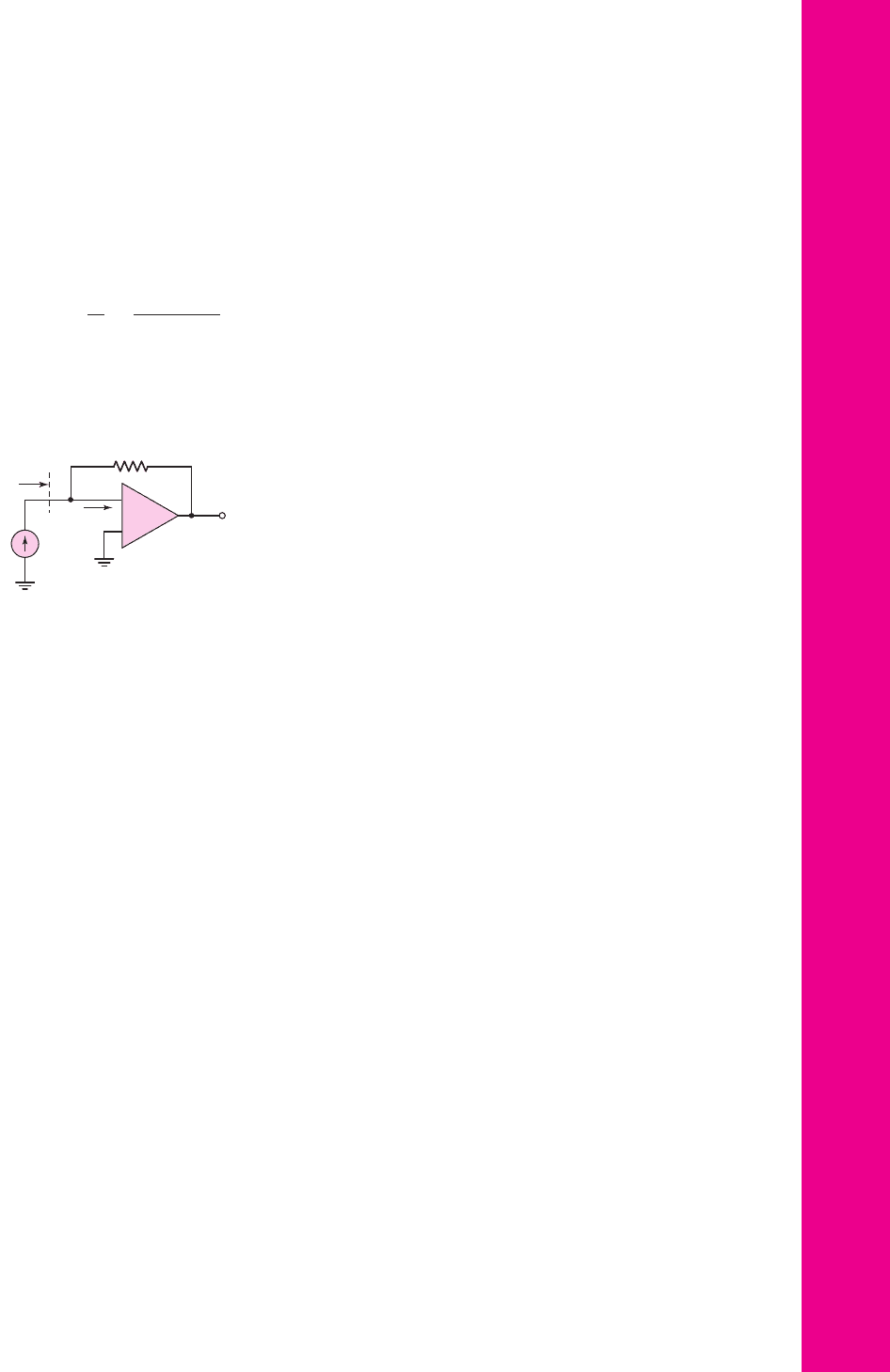
i
s
v
o
R
F
i
e
R
if
–
+
Figure P12.30
Chapter 12 Feedback and Stability
933
12.29 Voltage and current values in the ideal shunt–shunt circuit shown in
Figure 12.14 are
I
i
= 40 μA
,
I
fb
= 38 μA
, and
V
o
= 8
V. Determine the
values and units of A
z
,
A
zf
, and
β
g
.
12.30 Consider the current-to-voltage converter circuit shown in Figure P12.30.
The input resistance
R
if
is assumed to be small, the output resistance is
R
o
= 0
, and the op-amp gain A
z
is large. (a) Write the closed-loop transfer
function in the form
A
zf
=
v
o
i
s
=
A
z
(1 + β
g
A
z
)
(b) What is the expression for
β
g
? (c) If
A
z
= 5 ×10
6
and
A
zf
= 5 ×
10
4
, what is the required
β
g
and R
F
? (d) If A
z
decreases by 10 percent,
what is the percent change in
A
zf
?
12.31 For the current-to-voltage converter circuit in Figure P12.30, the parame-
ters are as described in Problem l2.30. If
R
i
= 10 k
, determine the closed-
loop input resistance
R
if
.
D12.32 Determine the type of feedback configuration that should be used in a de-
sign to achieve the following objectives: (a) low input resistance and low
output resistance, (b) high input resistance and high output resistance,
(c) low input resistance and high output resistance, and (d) high input resis-
tance and low output resistance.
12.33 Consider a series of amplifiers and feedback circuits connected in the ideal
feedback configurations. In each case the input resistance to the basic am-
plifier is
R
i
= 10 k
, the output resistance of the basic amplifier is
R
o
= 1k
, and the loop gain is
T = 10
4
. (a) Determine the maximum pos-
sible input resistance and minimum possible input resistance to the feed-
back circuit. (b) Determine the maximum possible output resistance and
minimum possible output resistance to the feedback circuit.
D12.34 A compound transconductance amplifier is to be designed by connecting
two basic feedback amplifiers in cascade. What two amplifiers should be
connected in cascade to form the compound circuit? Is there more than one
possible design?
Section 12.4 Voltage (Series–Shunt) Amplifiers
*12.35 The parameters of the op-amp in the circuit shown in Figure P12.35 are
A
v
= 10
5
,
R
i
= 30
k
, and
R
o
= 500
. The transistor parameters are
h
FE
= 140
and
V
A
=∞
. Assume that
v
O
= 0
at the quiescent point. De-
termine (a)
A
v f
, (b)
R
if
, and (c)
R
of
.
12.36 The circuit in Figure P12.36 is an example of a series–shunt feedback cir-
cuit. Assume the transistor parameters are:
h
FE
= 100
,
V
BE
(on) = 0.7
V,
nea80644_ch12_851-946.qxd 6/23/09 1:45 PM Page 933 pmath DATA-DISK:Desktop Folder:23/06/09:MHDQ134-12:
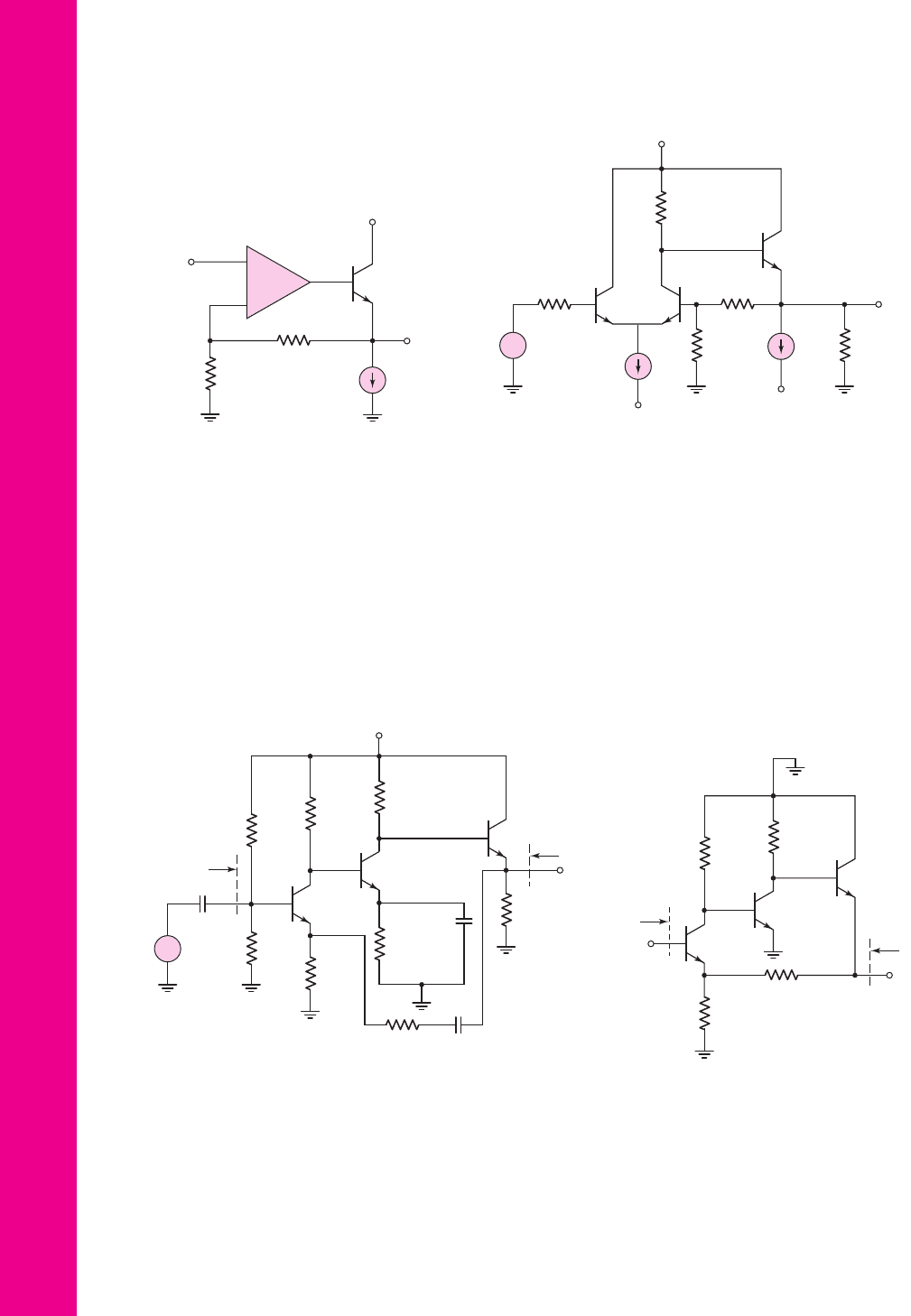
V
CC
= 10 V
R
2
=
75 kΩ
R
E1
=
0.5 kΩ
R
C1
=
8.8 kΩ
R
E2
=
3.6 kΩ
R
C2
=
13 kΩ
R
1
=
400 kΩ
R
E3
= 1.4 kΩ
R
F
=
10 kΩ
C
F
→ ∞
C
E
→ ∞
C
C
→ ∞
Q
2
Q
3
Q
1
v
o
v
i
R
if
R
of
+
–
Figure P12.37
R
C1
=
0.30 kΩ
R
C2
=
0.65 kΩ
R
F
= 1.2 kΩ
R
E
= 50 Ω
Q
2
Q
3
Q
1
V
o
V
i
R
if
R
of
Figure P12.38
and
V
A
=∞
. (a) Determine the quiescent collector currents and the dc volt-
age at the output. (b) Determine the small-signal voltage gain
A
v f
= v
o
/v
i
.
12.37 Consider the series–shunt feedback circuit in Figure P12.37, with transistor
parameters:
h
FE
= 120
,
V
BE
(on) = 0.7
V, and
V
A
=∞
. (a) Determine the
small-signal parameters for Q
1
, Q
2
, and Q
3
. Using nodal analysis, deter-
mine: (b) the small-signal voltage gain
A
v f
= v
o
/v
i
, (c) the input resistance
R
if
, and (d) the output resistance
R
of
.
934 Part 2 Analog Electronics
R
S
= 1 kΩ
R
C
= 22.6 kΩ
R
2
= 50 kΩ
Q
1
Q
2
Q
3
1 mA
2 mA
R
L
= 4 kΩ
R
1
=
10 kΩ
V
+
= 12 V
V
–
V
–
v
o
v
i
+
–
Figure P12.36
*12.38 The circuit shown in Figure P12.38 is an ac equivalent circuit of a feedback
amplifier. The transistor parameters are
h
FE
= 100
and
V
A
=∞
. The
quiescent collector currents are
I
C1
= 14.3
mA,
I
C2
= 4.62
mA, and
I
C3
=
R
2
= 10 kΩ
R
1
= 1 kΩ
I
Q
=
0.2 mA
V
CC
= 10 V
v
o
v
i
+
–
A
Figure P12.35
nea80644_ch12_851-946.qxd 6/23/09 1:45 PM Page 934 pmath DATA-DISK:Desktop Folder:23/06/09:MHDQ134-12:
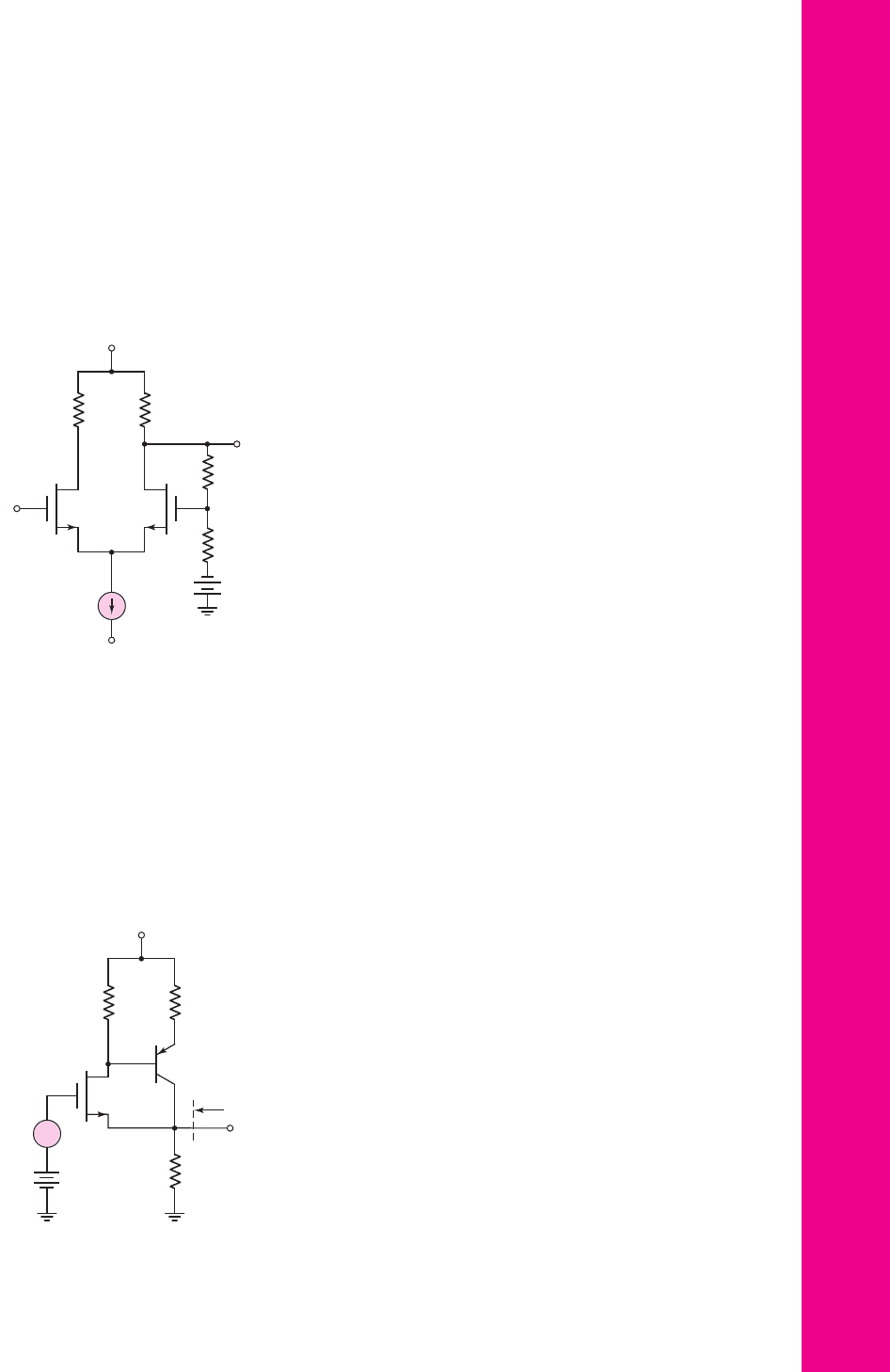
R
D1
R
E2
V
+
R
L
+
–
V
GG
M
1
Q
2
v
i
v
o
R
of
+
–
Figure P12.40
Chapter 12 Feedback and Stability
935
4.47 mA. (a) Determine the closed-loop voltage gain
A
v f
= V
o
/V
i
. Com-
pare this value to the approximate ideal value of
A
v f
∼
=
(R
F
+ R
E
)/R
E
.
(b) Determine the values of
R
if
and
R
of
.
12.39 Consider the MOSFET feedback amplifier shown in Figure P12.39. The
transistor parameters are
V
TN
= 0.5
V,
K
n
= 0.5
mA/V
2
, and
λ = 0
. Deter-
mine the small-signal voltage gain
A
v
= v
o
/v
i
.
1.5 V
R
D
=
7 kΩ
R
D
=
7 kΩ
R
1
= 200 kΩ
R
2
= 200 kΩ
+
–
V
+
= 5 V
M
1
M
2
I
Q
=
1 mA
V
–
= –
5V
v
o
v
i
Figure P12.39
*12.40 The parameters of the BiCMOS circuit in Figure P12.40 are
V
+
= 5
V,
V
GG
= 2.5
V,
R
D1
= 5
k
,
R
E2
= 1.6
k
, and
R
L
= 1.2
k
. The transis-
tor parameters are
K
n
= 1.5
mA
/
V
2
,
V
TN
= 0.5
V,
λ = 0
for
M
1
and
h
FE
= 120
,
V
EB
(
on
)
= 0.7
V,
V
A
=∞
for
Q
2
. (a) Determine the quiescent
values
I
DQ1
and
I
CQ2
. (b) Find the small-signal voltage gain
A
v
= v
o
/v
i
.
(c) Determine the small-signal output resistance
R
of
.
nea80644_ch12_851-946.qxd 6/23/09 1:45 PM Page 935 pmath DATA-DISK:Desktop Folder:23/06/09:MHDQ134-12:
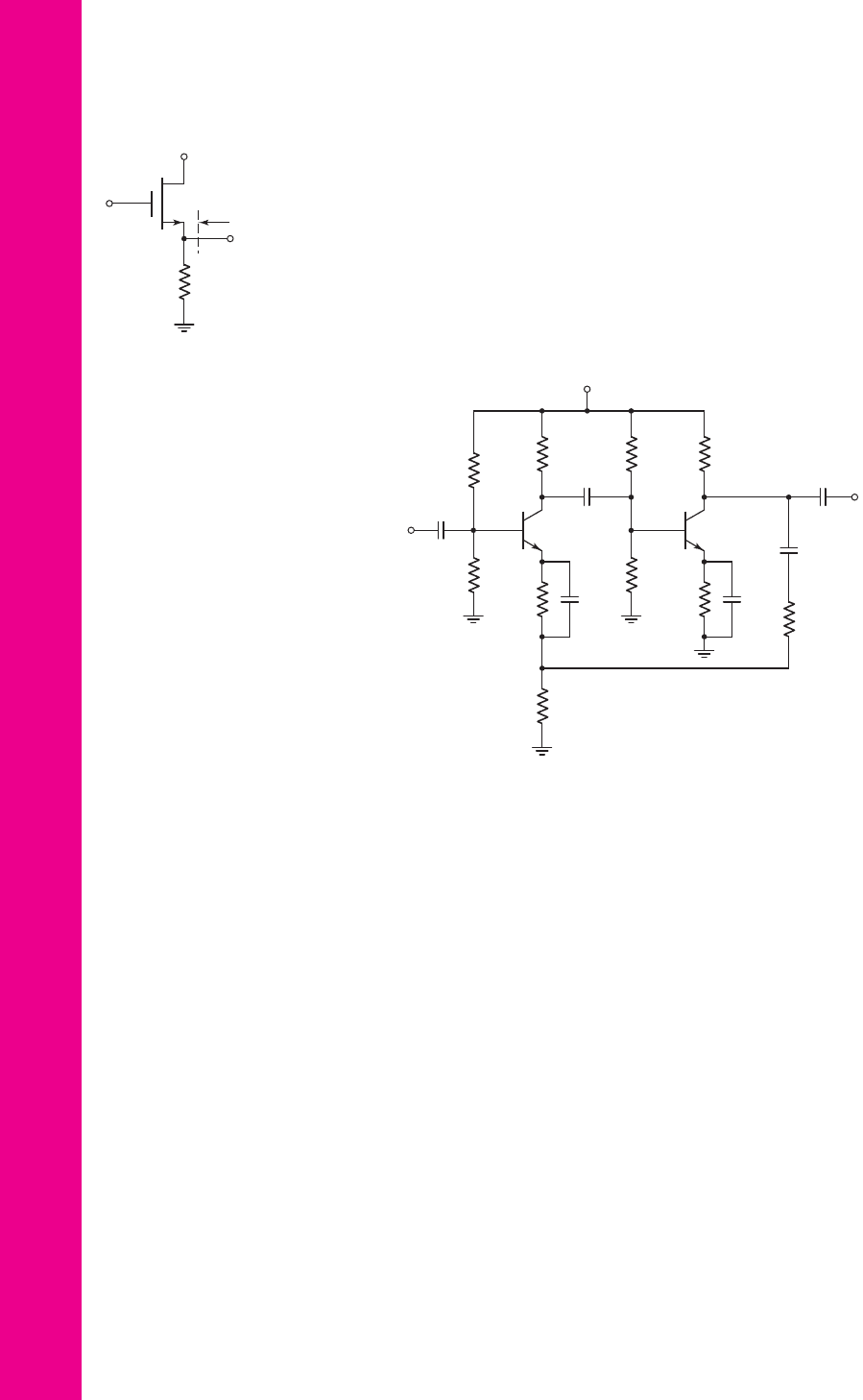
V
o
+25 V
V
S
4.7 kΩ
4.7 kΩ
47 kΩ
33 kΩ
R
2
=
4.7 kΩ
R
1
= 100 Ω
C
2
=
5
mF
C
4
=
50
mF
C
3
=
50
mF
C
6
=
5
mF
C
5
=
10
mF
4.7 kΩ
10 kΩ
150 kΩ
47 kΩ
C
1
=
5 mF
Q
2
V
1
Q
1
Figure P12.42
936 Part 2 Analog Electronics
12.41 The parameters of the basic source-follower circuit in Figure P12.41 are
R
S
= 1.5
k
,
V
TN
= 1.2
V, and
λ = 0
. Assume the transistor is biased at
I
DQ
= 1.2
mA. (a) If the transistor conduction parameter is
K
n
=
1.5
mA/V
2
, determine (i)
A
v f
= v
o
/v
i
and (ii)
R
of
. (b) If the conduction
parameter increases by 50 percent to
K
n
= 2.25
mA/V
2
, determine the
percent change in (i)
A
v f
= v
o
/v
i
and (ii)
R
of
.
12.42 The transistor parameters for the circuit in Figure P12.42 are:
h
FE
= 50
,
V
BE
(on) = 0.7
V, and
V
A
=∞
. Using nodal analysis, determine the closed-
loop small-signal voltage gain
A
v f
= v
o
/v
s
at the midband frequency.
*D12.43 Design a discrete transistor feedback voltage amplifier to provide a volt-
age gain of 50. Assume the available transistors have parameters:
h
FE
= 120
and
V
A
=∞
. The signal voltage source has a source resis-
tance of
R
S
= 2k
and the load is
R
L
= 3k
. Verify the design with a
computer simulation. Determine
R
if
and
R
of
.
*D12.44 Redesign the feedback circuit in Figure P12.36 using MOSFETs to pro-
vide a voltage gain of
A
v f
= 8
and such that
v
o
= 0
when
v
i
= 0
. Assume
circuit parameters of
R
S
= 1
k
,
R
1
= 15
k
, and
R
L
= 10
k
. The tran-
sistor parameters are
k
n
= 100 μA/V
2
,V
TN
= 1.5
V, and
λ = 0
.
Section 12.5 Current (Shunt–Series) Amplifiers
12.45 An op-amp current gain amplifier is shown in Figure P12.45. Assuming an
ideal op-amp, design the circuit such that the load current is
I
o
= 5
mA for
an input current of
I
s
= 60 μ
A.
*12.46 Consider the current gain amplifier shown in Figure P12.46. The transis-
tor parameters are
K
n
= K
p
= 10
mA/V
2
,
V
TN
= 1
V,
V
TP
=−1
V, and
λ
n
= λ
p
= 0
. The LED turn-on voltage is
V
γ
= 1.6
V. Assume the LED
small-signal resistance is
r
f
= 0
. (a) Determine the quiescent currents
I
DQ1
and
I
DQ2
. (b) Show that the small-signal current gain is given by
R
S
V
DD
v
i
v
o
R
of
Figure P12.41
nea80644_ch12_851-946.qxd 6/23/09 1:45 PM Page 936 pmath DATA-DISK:Desktop Folder:23/06/09:MHDQ134-12:
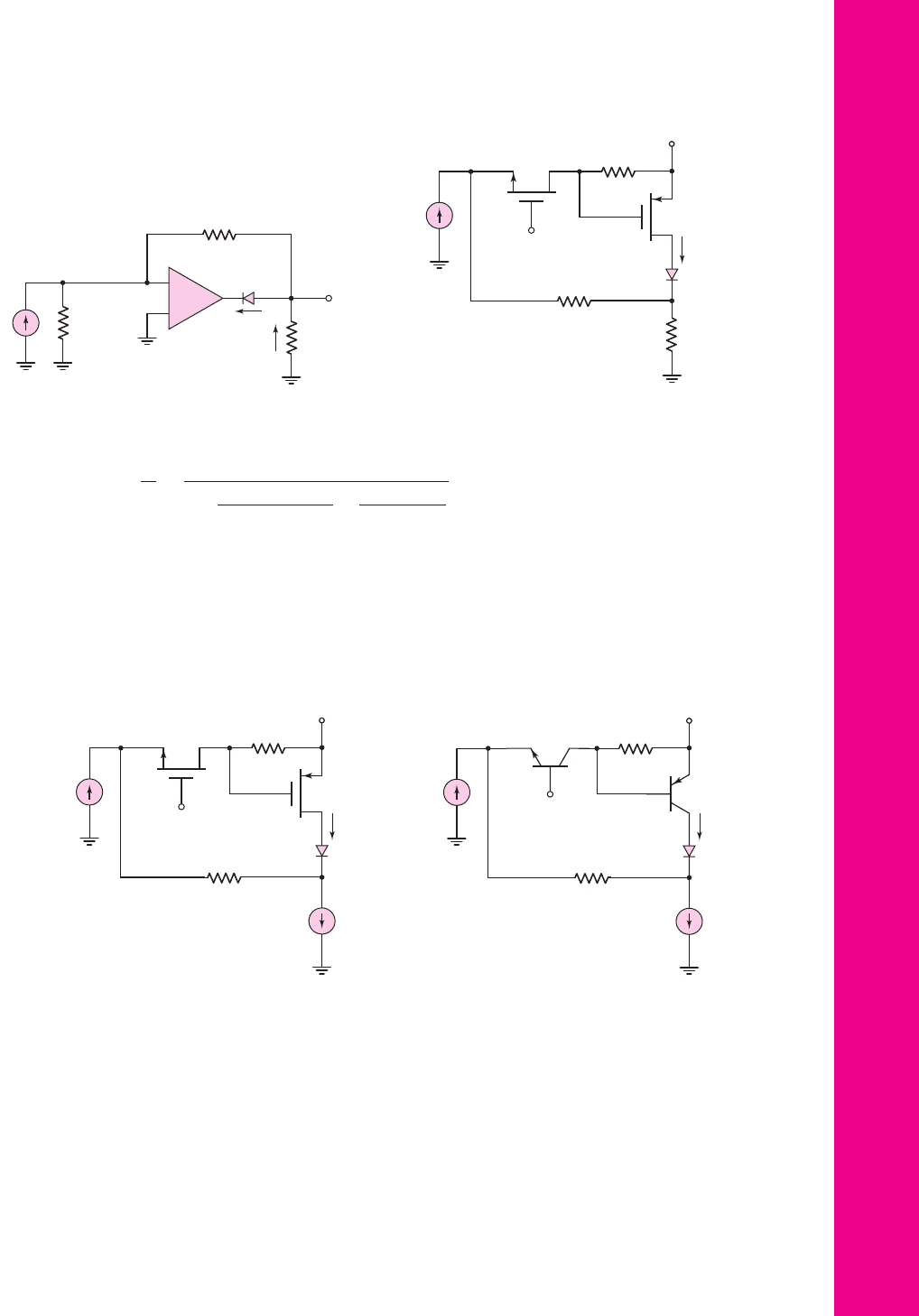
A
i
=
I
o
I
i
=
−g
m2
R
D1
1 +
1
g
m1
(R
F
+ R
D2
)
+
g
m2
R
D1
R
D2
R
F
+ R
D2
(c) Calculate the value of
A
i
.
*12.47 A MOSFET current gain amplifier is shown in Figure P12.47. The transis-
tor parameters are
K
n
= K
p
= 10
mA/V
2
,
V
TN
= 1
V,
V
TP
=−1
V, and
λ
n
= λ
p
= 0
. The LED turn-on voltage is
V
γ
= 1.6
V. Assume the LED
small-signal resistance is
r
f
= 0
. (a) Determine the quiescent currents
I
DQ1
and
I
DQ2
. (b) Determine the small-signal current gain
A
i
= I
o
/I
i
.
Chapter 12 Feedback and Stability 937
V
o
I
1
R
2
R
1
R
S
=
100 kΩ
LED
–
+
I
s
I
o
Figure P12.45
R
D1
= 525 Ω
V
+
= 10 V
R
F
= 500 Ω
V
G
= 7.6 V
R
D2
=
250 Ω
I
i
I
o
LED
M
1
M
2
Figure P12.46
R
D
= 525 Ω
V
+
= 10 V
R
F
= 500 Ω
V
G
= 7.6 V
I
i
I
o
LED
I
Q
=
16 mA
M
1
M
2
Figure P12.47
*12.48 A BJT current gain amplifier is shown in Figure P12.48. The transistor pa-
rameters are
β
1
= β
2
= 180
,
V
A1
= V
A2
=∞
, and
I
S1
= I
S2
= 10
−15
A.
The LED turn-on voltage is
V
γ
= 1.6
V. Assume the LED small-signal
resistance is
r
f
= 0
. (a) Determine the quiescent currents
I
CQ1
and
I
CQ2
.
(b) Derive the expression for the small-signal current gain
A
i
= I
o
/I
i
. (c) Cal-
culate the value of
A
i
= I
o
/I
i
.
12.49 The circuit in Figure P12.49 has transistor parameters:
h
FE
= 100
,
V
BE
(on) = 0.7
V, and
V
A
=∞
. (a) From the quiescent values, determine
R
C
= 200 Ω
V
+
= 5 V
R
F
= 500 Ω
V
B
= 3.6 V
I
i
I
o
LED
I
Q
=
16 mA
Q
2
Q
1
Figure P12.48
nea80644_ch12_851-946.qxd 6/23/09 1:45 PM Page 937 pmath DATA-DISK:Desktop Folder:23/06/09:MHDQ134-12:
